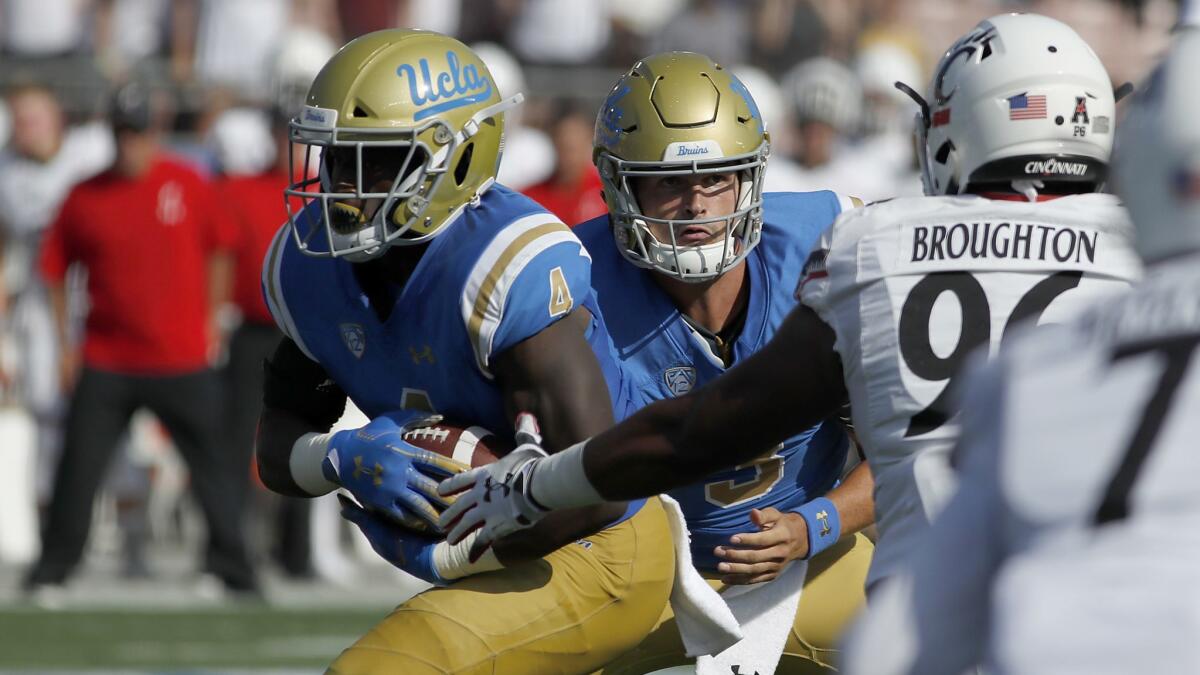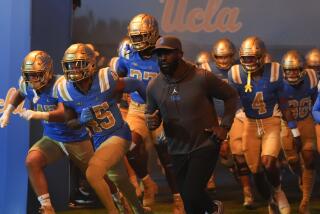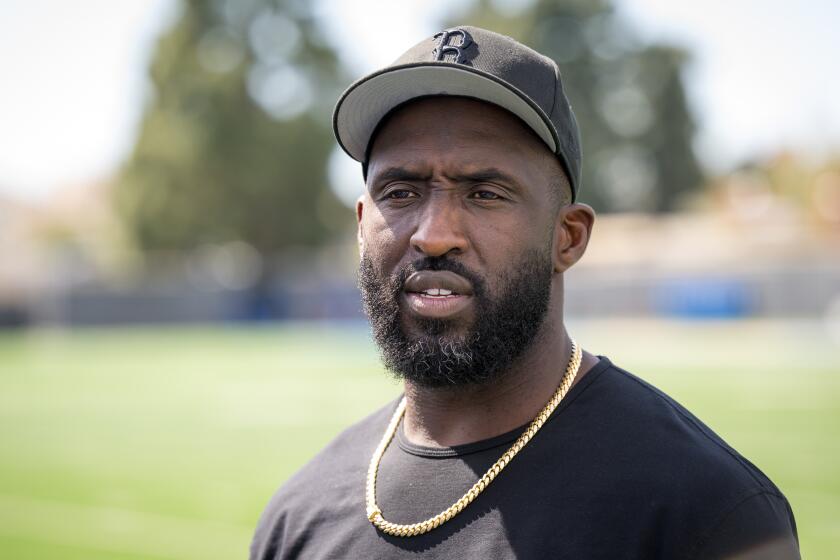UCLA’s Bolu Olorunfunmi says he’s healthy but also grateful for school policy on concussions that ended his season

- Share via
Bolu Olorunfunmi has felt good for about a week now. The mental fog the UCLA senior tailback experienced after his second concussion since August has lifted.
“I feel literally 100%,” Olorunfunmi said Wednesday during a telephone interview. “If they were to call me and say, ‘Can you still play?’ I would be like, ‘Yeah, let’s do it.’ ”
That call will not be coming. The UCLA medical staff recently declared Olorunfunmi and four other Bruins out for the rest of the season because of concussions. The decision ended Olorunfunmi’s college career but left him grateful for the protection from another potentially more serious brain injury.
“It’s their policy and I respect it,” Olorunfunmi said of the team physicians. “I’d rather be 50 and have a good brain than be 50 and have a damaged brain.”
Olorunfumi tweeted an update about his status Tuesday afternoon, shortly after The Los Angeles Times published a story online about the Bruins’ wave of season-ending concussions. UCLA has kept five players out, but Washington defensive back Austin Joyner is thought to be the only other Pac-12 Conference player to have been sidelined for the season by the same issue.
“I’m truly 100% Good and healthy,” Olorunfunmi tweeted along with an emoji of hands pressed together to show he was thankful. He added the hashtag “ButThePolicyTho” along with a shrugging emoji.
Olorunfunmi said he was told he was shut down for the season because he had suffered two concussions in less than three months. Asked if that was a team-wide policy, a UCLA athletic department official said each player was evaluated on an individual basis. Team medical personnel declined to comment about their concussion protocol.
Lawsuits do not appear to have triggered UCLA’s concussion policy given that the school was not listed as a defendant in two recent cases involving brain injuries suffered by former players Tom Sullivan and Rodney Stensrud.
Olorunfunmi said he wanted to speak out to let everybody know that he did not have a debilitating injury and was training for the NFL draft.
“That’s why I’ve been trying to voice that out, that it’s not out for the season like, oh, I’m finished, I have a torn ligament or I can’t use my arm or I can’t read now or something like that,” Olorunfunmi said. “No, it’s literally, we want you to be completely 100% fine. You may have to sacrifice these games so we know you’re fine and I understand that.”
Neither of the hits that caused Olorunfunmi’s concussions were direct blows to the head, he said. The first came when Olorunfunmi got walloped during training camp, sidelining him for three days. He returned wearing an over-sized helmet with additional padding designed to protect against concussions, along with a mandate from the training staff.
“They took it slow with me,” Olorunfunmi said, “and even though I would say, ‘I’m fine,’ like, ‘I feel good,’ they would say, ‘Take your time. You don’t want to rush things like this.’ ”
According to UCLA’s 2017 concussion management plan filed with the NCAA, players diagnosed with a concussion or who have suffered a head injury — even if they don’t show symptoms — are supposed to be held out of competition for the rest of that day. Players are then monitored to observe for signs of neurological deterioration or a prolonged recovery lasting longer than two weeks.
The return-to-play protocol involves a gradual progression including an initial period of rest lasting at least 24 hours followed by cardiovascular activity of 20 to 30 minutes, sport-specific activities, increased cardiovascular training, non-contract training and full-contact training. Only upon successful completion of each step can a player advance to the next one before ultimately being cleared to return to play.
Final authority for return to play resides with the treating team physician. The plan does not mention a policy for what might constitute a season-ending concussion.
Olorunfunmi had gone from the team’s leading ballcarrier in 2017 to a smaller role this season, mostly in short-yardage situations and on special teams. He said he was on the punt coverage team against California on Oct. 13 when he sustained his second concussion, though he initially kept his symptoms to himself.
“Like, you feel shaken up a little bit,” Olorunfunmi said. “That’s what I thought I was, shaken up. I played throughout the whole game, I finished the whole game. It was afterward they called me into the training room and I told them how I felt.”
Three days later, Olorunfunmi learned his college career was over. But the hope is that his football career will resume after he gets his degree this fall and enters the NFL draft next spring.
An NFL personnel executive said a prospect’s concussion history is considered in evaluating their draft stock, especially if they’ve had three or four in their college career and did not seem to recover in an expected manner. Being sidelined midseason because of a concussion, however, would not necessarily be a red flag.
“We wouldn’t hold it against any player,” said the personnel executive, who spoke anonymously because he is not authorized by his team to be quoted on such matters, “but we’d definitely let our medical staff dig into it.”
Olorunfunmi said he had no history of concussions before this season. Recent testing showed that his brain function had returned to normal, he said, but the fate of his season had been sealed.
“They don’t care if I came into the training room doing backflips and front flips tonight or today,” Olorunfunmi said. “It’s still like, ‘All right, we have to take it slow with you. Sorry you have to sit out for the rest of the season, but this is for your health.’ ”
Times staff writers Sam Farmer and Nathan Fenno contributed to this story.
Follow Ben Bolch on Twitter @latbbolch
More to Read
Go beyond the scoreboard
Get the latest on L.A.'s teams in the daily Sports Report newsletter.
You may occasionally receive promotional content from the Los Angeles Times.







